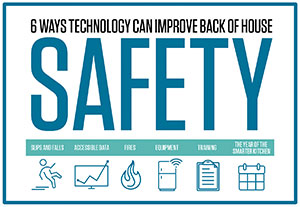6 ways technology can improve back-of-house safety.
By Tina Swanson
Safety is a top priority for any facility, no matter the operation or job. While it is one of the most-talked-about topics within the foodservice industry, restaurants and the like still struggle when it comes to creating a safe back-of-house (BOH) environment. Safety can not only bolster your restaurant’s bottom line, but it can also foster the productivity and satisfaction of your greatest asset: your employees.
The foodservice industry as a whole sees a high frequency of low-severity accidents. Only 2% of restaurant injuries are actually severe, with claims of $100,000 or more. The most effective way to avoid these accidents and costly medical and legal claims is to prevent them altogether. Having the right technology in place can certainly help. Here are six ways technology can help you maintain a safer, smarter kitchen for your restaurant workers and your profitability:
S: Slips and falls are the second most common injury that occurs in restaurants and can be prevented by eliminating outdated ways of accomplishing common kitchen tasks. Just behind cuts, lacerations and punctures for the Number 1 spot of common injuries are the slips and falls that happen most frequently near sinks and fryer vats. In fact, oil-related injuries account for 60% of BOH workers’ compensation claims. Ditch the old, hazardous way of manually managing cooking oil and let a closed-loop, automated system do the work for you and eliminate the splattering of slippery grease that can lead to accidents.
 A: Accessible data can improve efficiencies and relieve strain on your employees, resulting in a safer BOH environment. Despite the evolution of the digital age, only 12% of restaurant operators consider their operations to be leading-edge in tech use. When operators take advantage of technology and data, they can avoid messy and dangerous BOH situations. Start by connecting your kitchen with the Internet of Things and accessing important data such as the filtration occurences and cleanliness of cooking oil in order to decrease the amount of time employees are exposed to these potentially harmful working conditions.
A: Accessible data can improve efficiencies and relieve strain on your employees, resulting in a safer BOH environment. Despite the evolution of the digital age, only 12% of restaurant operators consider their operations to be leading-edge in tech use. When operators take advantage of technology and data, they can avoid messy and dangerous BOH situations. Start by connecting your kitchen with the Internet of Things and accessing important data such as the filtration occurences and cleanliness of cooking oil in order to decrease the amount of time employees are exposed to these potentially harmful working conditions.
F: Fires in the kitchen are more likely to happen when oil and grease build up over time — a deadly combination that may ignite at any moment. However, this dangerous situation can be avoided when your hoods, flues and fans are automatically cleaned every day, stopping buildup in its tracks. Consider implementing technology that performs this task automatically. Such a system can significantly mitigate fire risk so you can keep the lights on and maintain a clean and safe kitchen environment 24/7.
E: Equipment is essential to any kitchen, and it could mean the difference between a life-threatening injury and an accident fixed with just a bandage. Commercial kitchens are now investing in smarter, up-to-date systems — such as robotics and hands-free appliances — to replace dangerous and manually laborious tasks. Meanwhile, consumer-world technology is also making its way into the BOH, giving restaurants a tech-savvy leg up with voice-activated digital assistants and kiosk tablets appeasing employees and consumers. Invest in the latest equipment to give your teams the tools and technologies they need to do their jobs safely and efficiently. Such expenditures don’t have to happen overnight — even one new equipment purchase can bring about positive change, like having more engaged employees and fewer accidents.
T: Training is critical to ensure employees are practicing the safest protocols in your kitchen. Because the foodservice industry is one of the largest employers of teens, the pressure is on for restaurants to enforce the proper guidelines and training practices to keep even the youngest employees safe on the job. Include a safety training module every quarter at team meetings to keep protocols top of mind. Be sure to appeal to different learning styles by offering training through a variety of formats, such as visuals, books and audio recordings. Better yet, implement virtual-reality training that actually simulates BOH dangers and teaches employees how to handle them on the spot.
Y: The year of the smarter kitchen is here — and safety could be at the center of your future smarter kitchen. Commercial kitchen trends are going to continue to play a major role in how you optimize your safety protocols to better your operation. For example, labor costs are quickly overshadowing investments in futuristic kitchens; federal minimum wages are on the rise; and the talent pool is draining with BOH employee turnover at an all-time high. Your investments in technology go far beyond the upfront price tag, and they significantly decrease the chance of your employees suffering injuries. By creating a safer kitchen, you can battle the stress of affording and retaining labor in order to create a stronger workforce year over year.
Now is the time to bolster a future-proof strategy for your kitchen, and it starts by having the proper technologies and safety protocols in place. Realizing the impact of accidents and injuries, and knowing how to prevent them with the right technologies, can help make your BOH a safer workspace for employees and a more profitable operation for your business.
— Tina Swanson joined Restaurant Technologies in 2012 and currently leads the customer experience, account management and sales teams in order to maximize oil management and handling at each restaurant facility.
